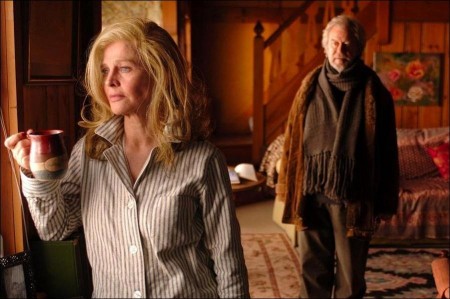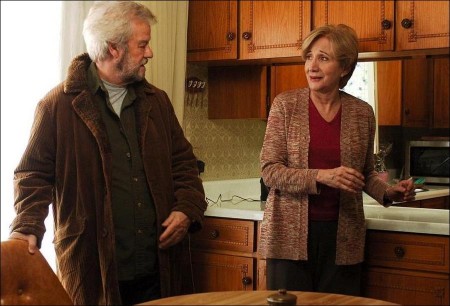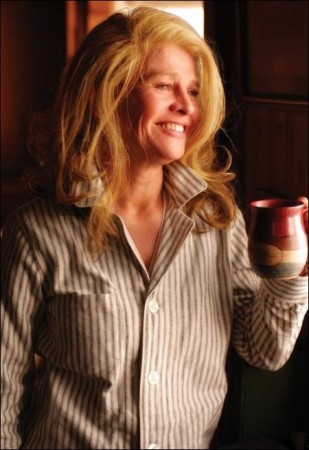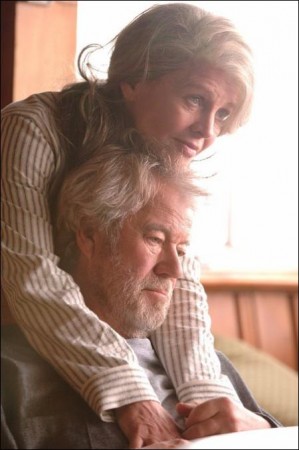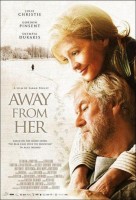Tagline: Sometimes you have to let go of what you can’t live without.
“Away From Her” is the lyrical screenplay adaptation of celebrated author Alice Munro’s short story “The Bear Came Over the Mountain.” A beautifully moving love story that deals with memory and the circuitous, unnamable paths of a long marriage.
Married for almost 50 years, Grant (Gordon Pinsent) and Fiona’s (Julie Christie) commitment to each other appears unwavering, and their everyday life is full of tenderness and humor. This serenity is broken only by the occasional, carefully restrained reference to the past, giving a sense that this marriage may not always have been such a fairy tale.
This tendency of Fiona’s to make such references, along with her increasingly evident memory loss, creates a tension that is usually brushed off casually by both of them. As the lapses become more obvious and dramatic, it is no longer possible for either of them to ignore the fact that Fiona is suffering from Alzheimer’s disease.
Sarah Polley had just completed work on Hal Hartley’s No Such Thing in Iceland when she read Alice Munro’s short story, The Bear Came Over The Mountain, the source material for her first feature film, Away From Her. “I was so unbelievably moved by the story,” she recalls.
“I had just finished working with Julie Christie, and as I read, I kept seeing Julie’s face in the character of Fiona. I’m certainly not one of those people who reflexively think about adapting stories – I just want to leave the things I love alone. But this fascinated me. I read the story and I saw the film.”
Known to most American audiences for her role as Nicole, the crippled, secretive daughter in Atom Egoyan’s The Sweet Hereafter, Polley has been acting since age six. In the last several years, she has also developed her skills as a filmmaker, having written and directed three short films, Don’t Think Twice, The Best Day of My Life and I Shut Love. For two years, Polley couldn’t stop thinking about Munro’s story, and she finally asked producer Daniel Iron, who produced Don’t Think Twice, to inquire about the film rights. “I threw myself into writing. But it’s daunting taking on the work of someone you respect so much,” admits Polley. “Alice Munro is one of my favorite writers because she looks right through things. The characters are all so flawed – so lovable in certain moments and so detestable in others. The adaptation didn’t feel like a huge process because the film was embedded in that story.”
In addition to Iron, Polley worked alongside producers Jennifer Weiss (who produced Polley’s Genie-award winning short, I Shout Love) and Simone Urdl, partners in the production company, The Film Farm. Renowned director Atom Egoyan served as executive producer. Having known and worked with Polley for years, Iron never doubted her ability to direct a feature. “I know how fiercely intelligent and diligent she is,” he says. “She’s been on sets since she was young and knows the craft better than any first time director. She shot-listed her first draft of the script.”
Egoyan agreed with Iron’s assessment. “I was aware, on The Sweet Hereafter, that Sarah was watching everything very closely,” he says. “It’s a natural progression. She has alarming maturity that comes through in the script.” Indeed, Polley’s understanding of the vagaries of a fifty-year marriage is all the more remarkable given the fact that she is twenty-seven years old and only a few years into her own marriage. Adds Egoyan, “There is an austerity, clarity and a dramatic through-line to her writing. It’s respectful of the source material and yet quite confidently able to expand on it as well. Away From Her does what cinema is able to do remarkably well, which is to take us, just through the human face, to places we don’t expect to travel.”
“Sarah was definitely ready to make a feature,” adds Jennifer Weiss. “If you watch her earlier films, you see she fits the Alice Munro style – there’s a subtlety and a simplicity at work. She knows how to work with actors to bring out the nuance in the same way that Alice Munro works with character.”
While Munro was not involved in the adaptation, she was pleased with the result, and left Polley a flattering voicemail message on December 23, 2005, a feather in the cap of the first-time feature director.
Away From Her is a love story about memory and devotion. The Andersson’s have remained committed to each other for fifty years, but now their marital tranquility is disrupted by Fiona’s failing memory at the hands of Alzheimer’s Disease. While Grant chooses to deny Fiona’s gradual deterioration, it soon becomes impossible to ignore.
Fiona first looses hold of recent memories – largely a good time in the Andersson’s marriage – and plunges back into the trauma of the past, resurrecting old emotions that both Fiona and Grant would rather forget.
“The role of Alzheimer’s in the film is a metaphor for how memory plays out in a long relationship: what we choose to remember, what we choose to forget,” says Urdl. “This love story moves you because you look at it from your own perspective and bring to it your own experiences,” adds Weiss. “It confirms that life is cyclical and we all go through the challenges of love and marriage and commitment.”
Polley wanted to explore how a long marriage survives without falling back on remembrances of a more romantic past, a gambit on which many films rely. Away From Her focuses on the emotional scar tissue of Grant’s and Fiona’s relationship, and how it continues to be a factor in their marriage. “Love stories about older people tend to be either extremely sentimentalized or justified by a million flashbacks to when they were young, which I think is a lot less interesting,” says Polley. “I wanted to make this relationship a real one that’s been through incredible things and come out the other side. It’s made up of all that experience and emotion and transgression.”
The Cast
The appeal of Away From Her lies in the casting as much as in the story. Oscar-winning actresses Julie Christie and Olympia Dukakis were joined by Gordon Pinsent and Michael Murphy, both award-winning actors in their own right. Says Weiss, “Having actors who we are all familiar with is crucial to the story because we have to feel connected with them from the beginning.”
Christie, Pinsent, Dukakis and Murphy represent the graying of the baby boomer generation, yet they redefine the image of old age as one full of vitality and vibrancy, where romance and sexuality are still dynamic forces. “You get to a certain age and you think all that stuff is gone and it’s not,” says Murphy, a veteran of such films as Annie Hall, Manhattan, M.A.S.H. and McCabe and Mrs. Miller. “I don’t feel any different than I did when I was 30. There’s a part of us that doesn’t belong to time. It’s a spirit thing.”
Julie Christie was the first, and only, person to be considered for Fiona Andersson, the charming, vulnerable woman who is described in Munro’s story as “ethereal, light and sly.” “Julie is captivating, magnetic and stunningly beautiful,” says Polley. “She has the sharpest mind and this piercing gaze into other people. She’s full of life and wonder and curiosity, and it’s impossible not to fall in love with her. But you’re always chasing her because she’s with you one second and not the next – and that was exactly my experience with the character of Fiona in the short story.”
“Julie surpassed all of our expectations,” avows Urdl. “Fiona has to be vibrant and with it, and then you have to see her deterioration. Julie has the ability to do that without appearing forced. She is so present and yet there is something ephemeral about her.”
Enter the discreet charm of actor/writer/director Gordon Pinsent, a Canadian icon. In what has been described by one journalist as a “career-defining role,” Pinsent, at age 75, plays Grant Andersson, a former university professor of mythology. “The initial reason I was attracted to this is because Sarah called me,” explains Pinsent. “I’d do anything for her. Then there’s the material, the role. It’s fantastic. In addition to the issue of Alzheimer’s, there is plenty going on underneath. And then we have Julie Christie and Olympia Dukakis. What’s not to like?”
As Pinsent embodies him, Grant still wields the considerable charm that helped him seduce young co-eds years ago; yet age has led him to fully appreciate the beauty and intelligence of his remarkable wife. “Grant had a few flighty years – other women, students and drugs,” says Pinsent. “But he eventually realized Fiona was the true love of his life.”
Polley was particularly pleased with the fresh pairing of Pinsent and Christie. “Gordon’s got a dignified quality and at the same time, he’s salt of the earth,” she says. “I love how completely different he and Julie are. It’s so inspiring when couples have been together for a long time, but retain their distinct and sometimes contradictory identities. These are people who have not melded into the couple monster.”
When Fiona becomes ill, Grant has to learn how to let go of his life’s most prized possession. “Grant’s trying to be strong, but he’s also feeling weak and guilty and he can’t do anything to save the woman he loves. Gordon plays all those emotions at the same time and it’s fascinating,” says Urdl.
“No matter what new people and new energies come into Grant’s life, nothing will ever, ever compare to Fiona,” adds Pinsent. “To have that taken away from him is devastating and he enters a period of time where he has no answers.”
What comes into his life are three women: Madeleine, the Meadowlake administrator, played by Wendy Crewson, Kristy, the head nurse at the facility, played by Kristen Thomson, and most notably, Marian. Played by Olympia Dukakis, Marian is the wife of Aubrey, a Meadowlake patient who becomes the unlikely object of Fiona’s affection.
Dukakis, who has acted as a spokesperson for the Alzheimer’s Association in the United States, found Away From Her to be a story of abiding love in an uncommon, and refreshing, shape and form. “It’s a non-traditional look at love and the ongoing-ness of life,” she says. “We think things end, but really life continues to reinvent itself.”
Marian and Grant are unexpectedly thrown together when their respective spouses, both suffering from debilitating illnesses, fall in love with each other. “It’s as unexpected for me as it is for Grant,” explains Dukakis. “Marian has to decide whether to stay angry about what life has dished up or to accept what has come her way. Sometimes, you just have to make a decision to be happy.”
Dukakis had worked with Polley previously on Thom Fitzgerald’s feature, The Event, and had seen several of Polley’s short films, but nothing prepared her for the maturity of Polley’s script. She says, “I couldn’t have expected such complexity and insight. It really is a fine piece of work.”
The part of Aubrey, Marian’s incapacitated husband, was an impressive about-face for the naturally exuberant Murphy, as the character never once speaks in the film. Since contracting a disease in the Third World, Aubrey has been confined to a wheelchair with no way of communicating to others. “The emotion is all conveyed through my face which I loved because I didn’t have to learn any lines,” laughs Murphy. “I play off the psychological.”
Murphy had the good fortune of working opposite an old friend in most of his scenes. In 1971, he and Julie Christie worked together on Robert Altman’s McCabe and Mrs. Miller. “Julie is no different now than she was then,” says Murphy. “Our relationship is right back where it was then, only better. I can get into those scenes with her big time.”
Rounding out the key cast are Kristen Thomson as Kristy and Wendy Crewson as Madeleine. Thomson starred in Polley’s award-winning short film, I Shout Love, and plays a sympathetic nurse who helps Grant attempt the transition that Alzheimer’s forces on his life. Crewson, who is married to Michael Murphy, plays the detail-oriented, efficient supervisor who takes the brunt of Grant’s anger.
Creating the look for Away From Her
Award-winning cinematographer Luc Montpellier first worked with Sarah Polley on her short film, I Shout Love, and worked with her again on “The Shield Stories,” a Canadian television series for which Polley wrote and directed one episode.
Understanding the vital role winter plays in the story, Montpellier wanted to capture the luminescent beauty of the season instead of focusing on its harshness. “My intention was to bathe Fiona’s and Grant’s relationship with cool winter source light and stay away from warm, romantic clichés,” he explains.
The cinematographer also sought to modify the filmmaking style according to the story’s locations. “In Grant’s and Fiona’s home, the scenes play out within precisely composed frames, like a series of still photographs, letting the actors move about freely. The photographic style changes when we arrive at Meadowlake. There, the Steadicam conveys Grant’s uneasiness with the place as he deals with the sorrow of what lies ahead for his wife.”
Montpellier’s biggest challenge, however, was finding a way to express the shifting textures of human memory. “I shot segments on a hand-held, hand-cranked Paillard Bolex H-16 converted to Super-16,” he explains. “The Bolex’s frame registration gave the images an un-fluid quality, sometimes full of clarity, and other times clouded by emotion, that I believe mirrors my experience with memory. Sarah and I then worked together on the computer to digitally manipulate the sequences to explore the look of memory.”
While Environment Canada reported that January 2006 was the mildest January in recorded history for many locations in Ontario, the first morning of principal photography at Lake of Bays near Bracebridge, Ontario began at a brisk minus 33 Celsius. “Everyone’s eyelashes had crystallized,” recalls Weiss. “We were shooting on a frozen lake and it was exquisite.
From the beginning, we wanted to capture rural Canada in a cinematic style. These locations, especially the exteriors, were crucial to understanding the characters and the life they set up for themselves. They made the choice to make life simpler. But life and history aren’t always simple.”
Alice Munro’s work is a testament to society and culture in rural and small town Ontario, Canada. For production designer Kathleen Climie, this meant revisiting locations of her youth. “Marian’s house is a perfect example,” she says. “Even though the house wasn’t described in the script, I felt exactly what that house was like. When we went to see it, it turned out that this was identical to the house that Sarah grew up in, same floor plan, same suburban neighborhood.”
Climie carefully considers the characters’ psychologies before designing the space they inhabit. For Marian, she knew the interior should be very structured. For Fiona, her instinct told her that the cottage be decorated with a mind towards comfort. “Fiona has curtains,” explains Climie. “Marian has drapes.”
The move to Meadowlake required a delicate shift in perspective. Says Climie, “Meadowlake, the location, was the embodiment of the transition in Fiona’s life from outdoors to indoors, from reality to a memory of that reality. So we created an oversized nature mural in the facility visiting area which became a perfect metaphor for that journey.”
Production notes provided by Lionsgate Films.
Away From Her
Starring: Julie Christie, Olympia Dukakis, Gordon Pinsent, Wendy Crewson, Michael Murphy, Kristen Thomson, Alberta Watson
Directed by: Sarah Polley
Screenplay by: Sarah Polley
Release Date: May 4th, 2007
MPAA Rating: PG-13 for strong language.
Studio: Lionsgate Films
Box Office Totals
Domestic: $4,571,521 (49.1%)
Foreign: $4,740,597 (50.9%)
Total: $9,312,118 (Worldwide)
